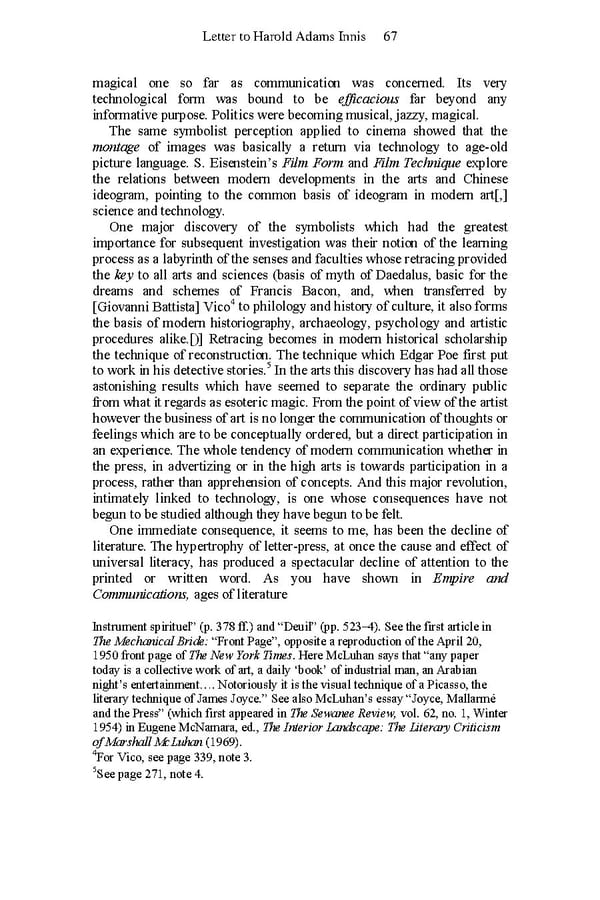Letter to Harold Adams Innis 67 magical one so far as communication was concerned. Its very technological form was bound to be efficacious far beyond any informative purpose. Politics were becoming musical, jazzy, magical. The same symbolist perception applied to cinema showed that the montage of images was basically a return via technology to age-old picture language. S. Eisenstein’s Film Form and Film Technique explore the relations between modern developments in the arts and Chinese ideogram, pointing to the common basis of ideogram in modern art[,] science and technology. One major discovery of the symbolists which had the greatest importance for subsequent investigation was their notion of the learning process as a labyrinth of the senses and faculties whose retracing provided the key to all arts and sciences (basis of myth of Daedalus, basic for the dreams and schemes of Francis Bacon, and, when transferred by 4 to philology and history of culture, it also forms [Giovanni Battista] Vico the basis of modern historiography, archaeology, psychology and artistic procedures alike.[)] Retracing becomes in modern historical scholarship the technique of reconstruction. The technique which Edgar Poe first put 5 to work in his detective stories. In the arts this discovery has had all those astonishing results which have seemed to separate the ordinary public from what it regards as esoteric magic. From the point of view of the artist however the business of art is no longer the communication of thoughts or feelings which are to be conceptually ordered, but a direct participation in an experience. The whole tendency of modern communication whether in the press, in advertizing or in the high arts is towards participation in a process, rather than apprehension of concepts. And this major revolution, intimately linked to technology, is one whose consequences have not begun to be studied although they have begun to be felt. One immediate consequence, it seems to me, has been the decline of literature. The hypertrophy of letter-press, at once the cause and effect of universal literacy, has produced a spectacular decline of attention to the printed or written word. As you have shown in Empire and Communications, ages of literature Instrument spirituel” (p. 378 ff.) and “Deuil” (pp. 523–4). See the first article in The Mechanical Bride: “Front Page”, opposite a reproduction of the April 20, 1950 front page of The New York Times. Here McLuhan says that “any paper today is a collective work of art, a daily ‘book’ of industrial man, an Arabian night’s entertainment…. Notoriously it is the visual technique of a Picasso, the literary technique of James Joyce.” See also McLuhan’s essay “Joyce, Mallarmé and the Press” (which first appeared in The Sewanee Review, vol. 62, no. 1, Winter 1954) in Eugene McNamara, ed., The Interior Landscape: The Literary Criticism of Marshall McLuhan (1969). 4 For Vico, see page 339, note 3. 5 See page 271, note 4.
 Essential McLuhan Page 73 Page 75
Essential McLuhan Page 73 Page 75